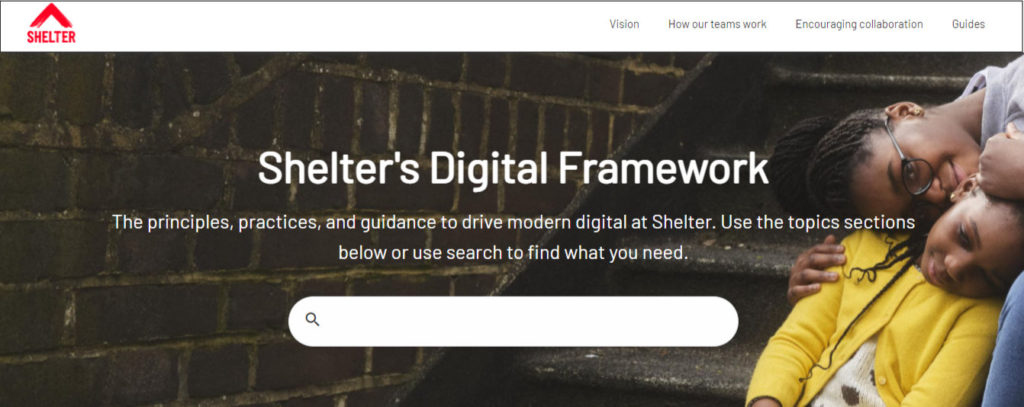- Intro
- From Powerpoint to website
- Helping contributors
- Spurning SharePoint
- Communications
- Gifting it to the charity sector
How does an organisation digitally transform? Buying new technology is merely one presumed way forward. But that’s only changing hardware and software. Real transformation involves people: what they’re aiming for, how they make decisions, and how they work – especially how they work together.
In 2018, after a consultant’s audit report gave Shelter a gauge of its digital maturity, capabilities and gaps, the charity put some of the report’s recommendations into action. Through a series of workshops, Shelter formed a new picture of how it will operate digitally, through a lean yet scalable model that included (among others):
- devolved web publishing
- full product and service lifecycle management
- increased user-centricity
- greater commitment to test-and-learn
- working principles to guide decisions
- a watertight content accountability structure – business owners, content owners and content managers
- communities of practice
Liberating the content from powerpoint
Caspar Below, head of digital, had led the workshops and follow-on thinking, and made a powerpoint deck to tell teams about the changes. So the next step was obvious: Build an online knowledge hub for all things digital working, from the overarching vision down to the guidelines and standards. We called it the digital framework.

Challenge: Giving Shelter a resource that held value for all the different people and roles connected to the charity’s digital work.
I started by talking to a wide range of people either in digital teams or with stakeholder status, like business owners. From those conversations, I ran a workshop to write out user stories, which fed directly into a number of IA and sitemap sessions.
I then developed a release plan which sequenced the launches of sections and topics. From there, I led on content creation – drafting the majority of pages*, designing graphics and diagrams, sourcing images, managing the workflow through Miro and a page tracking spreadsheet.
* We used 3-pairs-of-eyes for everything. Caspar drafted the vision-level pages – a perfect opportunity for him to articulate the underlying thinking and north stars for Shelter’s digital working.

Occupying the ‘important but not urgent’ square
Challenge: Getting digital leads and others to contribute. For some this meant providing guidance content for topics such as video production or email management. For others it meant drafting ‘how we work’ pages for topics like user research.

Although colleagues understood the larger context and saw the potential value in our plan, it was difficult for them to prioritise its content above their pressing day to day work.
To mitigate this, I built longer timeframes into their contributions. I gave them a month to send me something if they needed it. For three people I gave them templates to work from. For two others, I scheduled a 2 to 3 short catch-ups to help them build momentum in drafting pages, along with pair review sessions to go through their drafts.
Overcoming the inexorability of SharePoint
Challenge: Convincing Shelter’s IT team to let us use Confluence. Shelter considers itself a ‘Microsoft house’, meaning they’re committed to the full suite: Windows, Office 365, Teams, SharePoint, OneDrive, etc.
So it was a difficult conversation when I had to explain to the head of IT why I was building the framework site on Confluence, Atlassian’s competitor to SharePoint in the enterprise doc storage category. I made my case based on user needs, for end users and the people publishing.

SharePoint, for all its great features and integrations (with other MS products), is a source of frustration when managing the files and docs on it and a cause of befuddlement trying to find them.
Confluence matches Sharepoint for its range of important features and is a much friendlier publishing platform, with the same editorial look and feel as standard CMSs. Three digital teams had begun using Confluence for document storage but hadn’t yet built it into their processes. So for me it made sense to embrace the platform further and build the framework on it.
But to strengthen my case to IT, I found a Confluence front-end wrapper called Scroll Viewport in the Atlassian marketplace, designed as a help desk website with a practical navigation features like homepage tiles, and a potent search tool. Its presentation was much cleaner and more usable – and, unlike SharePoint, was mobile responsive.
I showed Scroll Viewport to the head of IT, and then showed him a selection of impenetrable Shelter team spaces in SharePoint. He reluctantly found it hard to disagree with me about its lack of usability and manageability, and he gave his okay for us to proceed with Confluence. (I even suggested doing some simple task analysis testing, but he’d already seen my point.)
Breaking out the trumpets
Challenge: Spreading the word and driving the usage. In the month ahead of the digital framework’s first release, we pondered how to communicate its existence and tout its benefits.
Our comms plan:
- A news item – along with a more permanent presence – on the Shelter intranet
- An org-wide email announcing its launch and later its second release
- Getting ourselves invited to other teams’ meetings, to give a peppy five minute talk about the framework
- A series of tweets and posts
- Enlisting the third sector media, which generated coverage from Zoe Amar and Charity Digital.
A gift from one charity to the others
Another important choice came from our plans: the decision to make the framework public. For most of its content, this was nothing bold and brave. Organisations have made their design systems, style guides, and brand guidelines open for a long time.
What I think was courageous was sharing the layer of transformational thinking: Shelter’s vision for change, its governance structures, and its new models and practices for driving decisions, collaboration and culture. Shelter made it all free to use under a Creative Commons license, as a way to pay back to the third sector for all it had learned from other charities.
The hope was that it would help:
- smaller charities who want to improve their digital working but can’t afford the consultants
- bigger charities still getting to grips with their transformation
- public sector bodies (especially local authorities) in the same boat
To date, close to ten charities have contacted Shelter’s digital team to pick their brain about facets of the framework.
Read about the Great Shelter Content Migration or about my adventures in content advocacy.